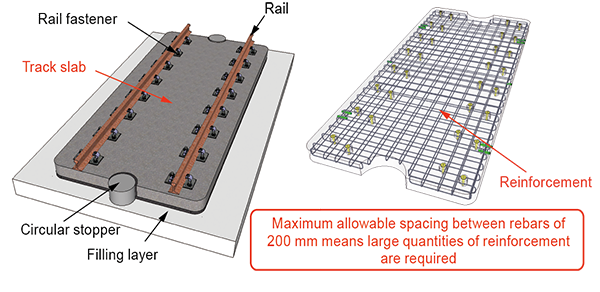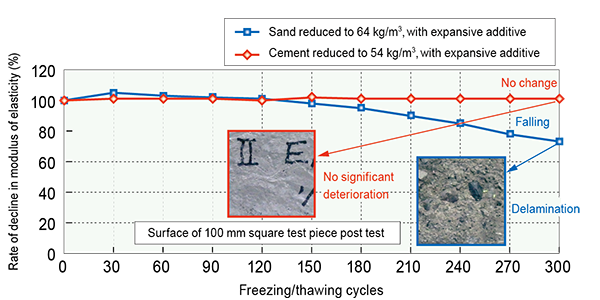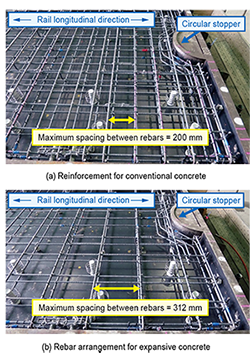19. Using expansive concrete in track slabs to minimize reinforcement
Track slabs are a key component of ballastless track (also known as slab track), which has been carrying train loads for more than 50 years. The reinforcement quantities currently specified for track slabs provide little margin for cracking. Meanwhile, it is effectively impossible to cut back on reinforcement as a cost-saving measure, because the maximum spacing between rebars is strictly defined in the specification (see Figure 1). Our track slab design requires less reinforcement thanks to the use of expansive concrete, which expands as it hardens. The volumetric expansion of the expansive concrete is constrained by the reinforcing bars, generating compressive force that acts to suppress cracking. This allows us to reduce the quantity of reinforcement used. Meanwhile, excessive volumetric expansion can itself cause damage, which may impact on frost resistance.
We investigated a number of different formulations and conducted a series of freezing/thawing tests in order to better understand the impact of the concrete mix proportion (including expansive additives) on volumetric expansion and frost resistance characteristics. We found that a good balance of concrete strength and volumetric expansion can be achieved by introducing the expansive additive at the expense of cement rather than sand, with only a relatively small quantity of additive needed to obtain the required expansion. Frost resistance is also equivalent to conventional track slabs (see Figure 2). Designed to comply with the existing limit for crack width, our track slab requires one-third less reinforcement and delivers a 5% saving in manufacturing costs (see Figure 3).
Other Contents
- 9. Integrated analytics platform for railways
- 10. On-board obstacle detection system suitable for low-light conditions
- 11. Tool for estimating bridge deflection from on-board track irregularity measurements
- 12. Wear measuring apparatus for overhead conductor rail using light sectioning
- 13. Imaging analysis method for detecting various anomalies in overhead contact lines
- 14. Automated crew scheduling system
- 15. Fast-track embankment structure for confined settings
- 16. Numerical analysis method for predicting interaction impacts on closely adjacent tunnels
- 17. Method for evaluating girder vibration characteristics with consideration for track rigidity
- 18. Concrete repair methodology based on crack width and location
- 19. Using expansive concrete in track slabs to minimize reinforcement
- 20. Using temperature sensors to help predict service life of electronic signallingequipment
- 21. Effective and efficient steam weeding technique
- 9. Integrated analytics platform for railways
- 10. On-board obstacle detection system suitable for low-light conditions
- 11. Tool for estimating bridge deflection from on-board track irregularity measurements
- 12. Wear measuring apparatus for overhead conductor rail using light sectioning
- 13. Imaging analysis method for detecting various anomalies in overhead contact lines
- 14. Automated crew scheduling system
- 15. Fast-track embankment structure for confined settings
- 16. Numerical analysis method for predicting interaction impacts on closely adjacent tunnels
- 17. Method for evaluating girder vibration characteristics with consideration for track rigidity
- 18. Concrete repair methodology based on crack width and location
- 19. Using expansive concrete in track slabs to minimize reinforcement
- 20. Using temperature sensors to help predict service life of electronic signallingequipment
- 21. Effective and efficient steam weeding technique



